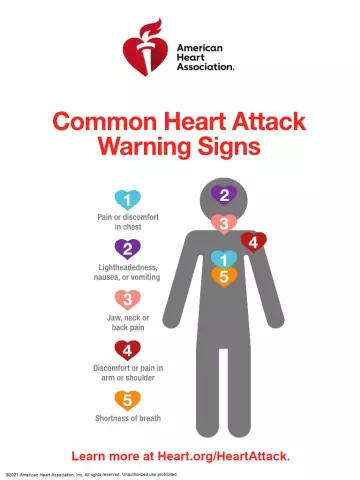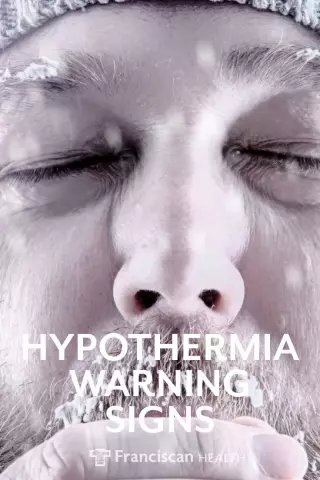- Author Rachel Wainwright [email protected].
- Public 2023-12-15 07:39.
- Last modified 2025-11-02 20:14.
First aid for fainting
Fainting is a short-term loss of consciousness caused by brain hypoxia. The cause of hypoxia is most often violations of the vascular bed, occurring due to various factors, from being in a stuffy room to anemia. Fainting is not a life-threatening condition in itself, but it can be a symptom of a dangerous medical condition, such as stenosis of the pulmonary or coronary artery.
Despite the short duration of this pathological condition, it is necessary to be able to provide first aid, since it is perhaps the most common of all acute pathologies after bleeding.
Signs of fainting and its difference from other pathologies with similar symptoms
Despite the suddenness, fainting still has the so-called harbingers, thanks to which people usually feel it approaching in advance. Harbingers of fainting include:
- Weakness;
- Nausea;
- Flickering "flies" before the eyes, darkening in the eyes;
- Pallor of the skin;
- Cold perspiration;
- Tinnitus.
A short time after the onset of these symptoms, the person loses consciousness.
Fainting is to be distinguished from coma and epileptic seizure. If ordinary fainting does not require hospitalization of the patient, then in these conditions it is necessary. It is easy to make a mistake, because in all three cases there is a loss of consciousness. The only difference is that when fainting, it is short-lived, lasts no more than 5 minutes, usually 1-2 minutes. It should be borne in mind that if fainting is prolonged (3-5 minutes), salivation, seizures and involuntary urination may occur, which sometimes leads to the fact that fainting is confused with an epileptic seizure. It is difficult for a layman to determine the difference, therefore, if first aid did not help with fainting and the person is unconscious for 5 minutes or more, an ambulance should be called.
First aid for fainting

The cause of fainting is oxygen starvation of the brain, caused, to put it simply, by sharply deteriorated blood flow to the brain. The easiest and most logical way to adjust the blood supply to the upper point of the body, which is the head, is to give the body a horizontal position. It is this simple action that is the main first aid measure for fainting. You also need to do everything necessary for the victim to gain access to fresh air: loosen clothes that are too tight, open a window in a stuffy room.
As a rule, this is sufficient and no other assistance is required. If a person with a chronic illness faints, then having come to his senses, he needs to consult a doctor or take medication in accordance with the instructions given to him by the doctor in advance.
If in the supine position, provided with fresh air, the victim did not regain consciousness, he should be put on his side so that he does not choke on vomit and suffocate due to a sunken tongue, and call an ambulance. Before the ambulance arrives, you cannot leave a person unconscious alone. The doctor should be called even if the victim regained consciousness, but his state of health remains poor.
First aid errors
Normal fainting does not pose a critical threat to life and health, especially if first aid is provided correctly. But, despite the simplicity of measures to provide assistance in this state, often people who sincerely want to be useful make mistakes that are sometimes more dangerous than fainting itself.
Mistake 1 - not letting the victim lie down. For some reason, it is widely believed that a person who fainted should not be allowed to lie down. There is nothing further from the truth. In case of fainting, it is imperative to lie down, just taking into account the fact that a person's consciousness is turned off, and he falls, you need to try to make sure that the victim is not injured when falling. Simply put, you cannot let fall, but let lie - you need to.
Mistake 2 - taking medications. If fainting occurs in a crowded place, which is what usually happens, since a large crowd of people leads to stuffiness and overheating, there will certainly be a kind-hearted person who is ready to share the pills he carries with him "just in case." As a rule, this is something from the heart drugs, most often nitroglycerin, or an antihypertensive agent. This should not be allowed. In case of fainting, drug support is not required at all, and such drugs not only will not help, but also significantly worsen the condition, lowering the pressure that has already fallen during fainting.
Mistake 3 - ammonia. Even in some medical sources, you can find information that, as a first aid measure for fainting, you need to bring a cotton swab or a bottle of ammonia to the victim's nose. This is mistake. Ammonia, which has a pungent smell, can help at the stage of harbingers of fainting, when a person feels impending lightheadedness, but has not yet lost consciousness. An unconscious person cannot recoil, caustic vapors of ammonia when inhaled easily cause a chemical burn of the mucous membrane. In addition, ammonia can lead to reflex spasm and respiratory arrest.
Mistake 4 - hitting the victim on the cheeks. This is also an old way of bringing to life a person who has lost consciousness, more than once played out by the cinema. But what's good for cinematography isn't always good for life. Weak slaps will not help in any way, but strong slaps can hurt - when a person is unconscious, it is easy not to calculate the strength and cause injury to soft tissues, and this is still the best case. Such treatment is worse than the disease itself - after fainting, the victim recovers within an hour, and the bruises go away much longer.
Mistake 5 - splashing water on the victim. A useless action in the warm season and potentially harmful in the cold.
Output
Remember that help must be competent, because excessive actions can lead to the opposite of the expected result. All you need to do as first aid for fainting is:
- Lay down the victim;
- Provide fresh air.
In doubtful cases, call a doctor.
Found a mistake in the text? Select it and press Ctrl + Enter.






